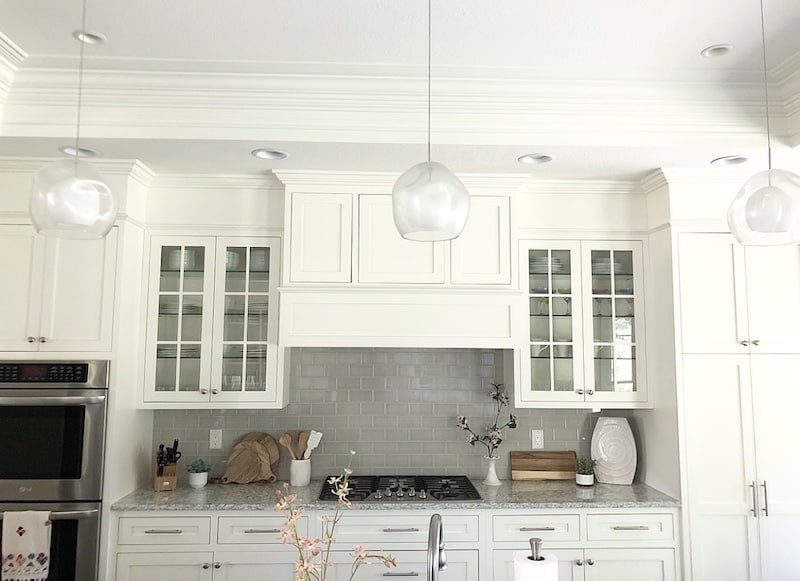Solutions for Addressing Small Gaps

You’ve prepped the intro and outro, and tackled the big gaps. Now, let’s get those pesky little gaps between your cabinets and ceiling sorted. We’re talking about those tiny, but noticeable spaces that can make your kitchen look less than perfect. No worries, we’ve got the solutions you need to fill those gaps and achieve a seamless finish.
Filling Materials
Filling those small gaps requires the right tools for the job. There are a few common options: caulk, spackle, and wood filler. Let’s break down the pros and cons of each to help you make the best choice for your project.
- Caulk is a flexible sealant that comes in various colors and finishes. It’s great for sealing gaps that move, like those around windows and doors. Caulk is also easy to apply and smooth out, making it a popular choice for small gaps. It’s best for filling gaps up to 1/2 inch wide.
- Spackle is a paste-like material that dries hard and is commonly used to fill holes and cracks in drywall. It’s good for filling larger gaps and can be sanded smooth for a seamless finish. However, spackle is not as flexible as caulk, so it’s not ideal for areas that move.
- Wood filler is a paste or putty that is used to fill holes and cracks in wood. It comes in various colors and finishes to match the surrounding wood. Wood filler is a good choice for filling gaps between cabinets and ceilings, especially if the cabinets are made of wood. It can be sanded smooth and painted for a seamless finish.
Application Guide
Once you’ve chosen your filling material, it’s time to get to work! Follow these steps for a professional-looking finish:
- Prepare the Surface: Before you start filling, make sure the surfaces are clean and dry. Remove any loose debris or dust with a damp cloth. You can also lightly sand the edges of the gap to create a smoother surface for the filling material.
- Apply the Filling Material: Use a caulking gun to apply caulk, or a putty knife to apply spackle or wood filler. Apply the material in a smooth, even layer, making sure to fill the entire gap. Avoid applying too much material, as this can make it difficult to smooth out.
- Smooth and Finish: Once the filling material is applied, use a damp finger or a putty knife to smooth it out. For caulk, you can use a tool called a caulk smoother to create a smooth, even finish. For spackle and wood filler, you can use a putty knife to smooth out the material and then sand it down for a seamless finish. Let the material dry completely before painting or staining.
Prevention Strategies for Gap Formation: Small Gap Between Cabinets And Ceiling

Small gap between cabinets and ceiling – Gaps between cabinets and ceilings are a common annoyance, but with a little foresight and planning, you can minimize the chances of them happening. The key is to focus on proper installation and preparation.
Importance of Proper Cabinet Installation and Securing Techniques
Just like a well-built house, your cabinets need a strong foundation to stand the test of time. Proper installation is crucial to prevent gaps from forming as your cabinets settle or experience shifting.
- Leveling and Plumb: Ensure your cabinets are perfectly level and plumb before securing them to the walls. Using a level and plumb line is essential to prevent sagging or tilting that can lead to gaps.
- Secure Fasteners: Use high-quality screws and fasteners that are long enough to penetrate the wall studs. Avoid using nails, as they are prone to loosening and can contribute to gaps.
- Reinforcement: Consider adding extra support to your cabinets, especially for larger units or those carrying heavy loads. This can be achieved through bracing, cleats, or additional fasteners.
Role of Wall and Ceiling Preparation in Preventing Gaps, Small gap between cabinets and ceiling
The surface your cabinets are being installed on also plays a critical role in preventing gaps. A well-prepared wall and ceiling provide a stable foundation that helps ensure a smooth and gap-free installation.
- Smooth and Level Surfaces: Before installing your cabinets, ensure that the walls and ceiling are smooth and level. Any bumps, dips, or unevenness can create gaps as the cabinets settle.
- Moisture Control: Moisture can cause wood to warp or expand, leading to gaps. Make sure your walls and ceiling are dry and free from any moisture issues before installation.
- Proper Shimming: Shims can be used to fill any small gaps or inconsistencies between the cabinet and the wall. Use shims sparingly and ensure they are properly secured to prevent movement.
That awkward space between your cabinets and the ceiling? It’s like a tiny, dusty kingdom for lost Tupperware lids. But fear not, dear reader! You can reclaim this forgotten territory with a corner wall cabinet organizer. It’s like a magic spell, turning your unused space into a haven for spices, extra plates, or perhaps even a secret stash of cookies (we won’t judge).
So, banish the dust bunnies and embrace the joy of a fully utilized kitchen!
That pesky gap between your cabinets and ceiling? It’s like a tiny, taunting reminder of wasted space. But fear not, fellow storage enthusiasts! The elite 32 stackable wall cabinet is here to conquer that vertical frontier, turning your kitchen’s dead zone into a haven for Tupperware and forgotten spices.
After all, who needs dust bunnies when you can have perfectly organized, accessible storage?